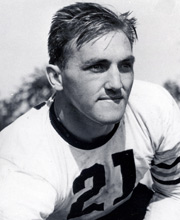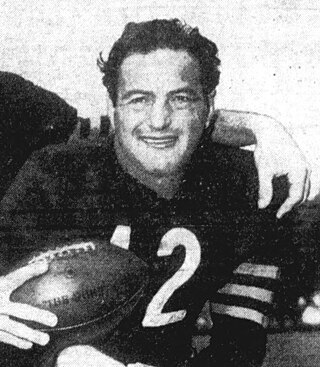
Sidney Luckman was an American football quarterback who played for the Chicago Bears of the National Football League (NFL) from 1939 through 1950. During his 12 seasons with the Bears, he led them to four NFL championships in 1940, 1941, 1943, and 1946.

George Stanley Halas Sr., nicknamed "Papa Bear" and "Mr. Everything", was an American football end, coach, and executive. He was the founder and owner of the Chicago Bears of the National Football League (NFL), and served as his own head coach on four occasions. He was also lesser-known as a player for the New York Yankees of Major League Baseball (MLB). He is the namesake for the NFC Championship trophy.

Ernest Alonzo Nevers, nicknamed "Big Dog", was an American football and baseball player and football coach. Widely regarded as one of the best football players in the first half of the 20th century, he played as a fullback and was a triple-threat man known for his talents in running, passing, and kicking. He was inducted with the inaugural classes of inductees into both the College Football Hall of Fame in 1951 and the Pro Football Hall of Fame in 1963. He was also named in 1969 to the NFL 1920s All-Decade Team.

Clyde Douglas "Bulldog" Turner was an American professional football player and coach in the National Football League (NFL). He was elected, as a player, to the College Football Hall of Fame in 1960 and the Pro Football Hall of Fame in 1966. He was also selected in 1969 to the NFL 1940s All-Decade Team.

Edward Francis Healey Jr. was an American professional football player in the National Football League (NFL). Regarded as one of the best linemen in the league's early days, Healey was inducted into the Pro Football Hall of Fame as part of its second induction class in 1964. He was also named in 1969 to the NFL 1920s All-Decade Team. In 1974, he was also inducted into the College Football Hall of Fame.

William Clarke Hinkle was an American football fullback and linebacker for the Green Bay Packers of the National Football League (NFL), also playing occasionally as a placekicker and punter. He was elected to the Pro Football Hall of Fame as part of its second class of inductees in 1964.

Walter Andrew Kiesling was an American football guard who spent 36 years as a player, coach, and aide with National Football League (NFL) teams. He was posthumously inducted into the Pro Football Hall of Fame in 1966 and was named to the NFL 1920s All-Decade Team in 1969.

August Michael Michalske, sometimes known as "Iron Mike", was an American football player and coach. He was inducted into the Pro Football Hall of Fame as part of its second induction class in 1964. He was also named in 1969 to the NFL 1920s All-Decade Team.
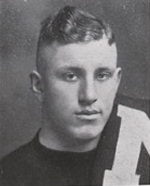
William Roy "Link" Lyman, also sometimes known as Roy Lyman, was an American football player and coach.
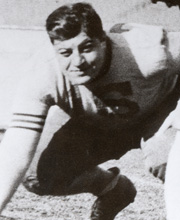
George Francis Musso was an American football guard and offensive tackle who spent his entire 12-year career for the Chicago Bears of the National Football League (NFL). He was inducted into the Pro Football Hall of Fame in 1982.

Joseph Lee Stydahar nicknamed "Jumbo Joe", was an American football player and coach. He was inducted into the Pro Football Hall of Fame in 1967 and the College Football Hall of Fame in 1972.

Berlin Guy "Champ" Chamberlin, sometimes misspelled Guy Chamberlain, was an American professional football player and coach. He was inducted into the College Football Hall of Fame in 1962 and the Pro Football Hall of Fame in 1965. He was also named in 1969 to the NFL 1920s All-Decade Team.
The 1936 NFL draft was the first draft of National Football League (NFL). It took place on February 8, 1936, at the Ritz-Carlton Hotel in Philadelphia, Pennsylvania. The draft was instituted in an effort to end bidding wars among the league's teams by the arbitrary assignment of negotiating rights to amateur players. It was haphazardly decided that the last place team from the previous season would get the first selection, and the process would continue in reverse order of the standings. Under this structure the Philadelphia Eagles, who finished 1935 at 2–9, would select first.

John Leo "Paddy" Driscoll was an American football and baseball player and football coach. A triple-threat man in football, he was regarded as the best drop kicker and one of the best overall players in the early years of the National Football League (NFL). He was inducted into the Pro Football Hall of Fame in 1965 and the College Football Hall of Fame in 1974.

Edward Alexander Sprinkle was an American football defensive end and end who played for the Chicago Bears of the National Football League (NFL). He was known to many as "the Meanest Man in Pro Football" and was nicknamed "the Claw". He played for 12 seasons with the Bears and is credited with calling attention to the NFL's defensive players.
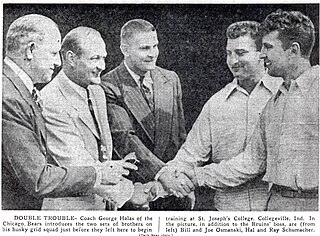
William Thomas Osmanski, nicknamed "Bullet Bill", was an American professional football player who was a fullback for the Chicago Bears of the National Football League (NFL). He was briefly a head coach after his playing career. He was inducted into the College Football Hall of Fame in 1973 and in 1977 he was inducted into the National Polish-American Sports Hall of Fame.
The 1943 season was the Chicago Bears' 24th in the National Football League. The team failed to match on their 11–0 record from 1942 and finished at 8–1–1, under temporary co-coaches Hunk Anderson and Luke Johnsos. On the way to winning the Western Division, the Bears were, yet again, denied a chance at an undefeated season by the defending champion Redskins in Washington. The Bears had their revenge in the NFL title game and defeated the Redskins at Wrigley Field to claim their sixth league title. It was their third championship in four years, establishing themselves as the pro football dynasty of the early 1940s.
The 1944 season was the Chicago Bears' 25th in the National Football League. The team was co-coached by Hunk Anderson and Luke Johnsos with Paddy Driscoll as the assistant coach.

Elmer Kenneth Strong was an American professional football player who was a halfback and fullback. He also played minor league baseball. Considered one of the greatest all-around players in the early decades of the game, he was inducted into the College Football Hall of Fame in 1957 and the Pro Football Hall of Fame in 1967 and was named to the NFL 1930s All-Decade Team.

The Colgate Raiders football team represents Colgate University in NCAA Division I Football Championship Subdivision (FCS) college football competition as a member of the Patriot League.
